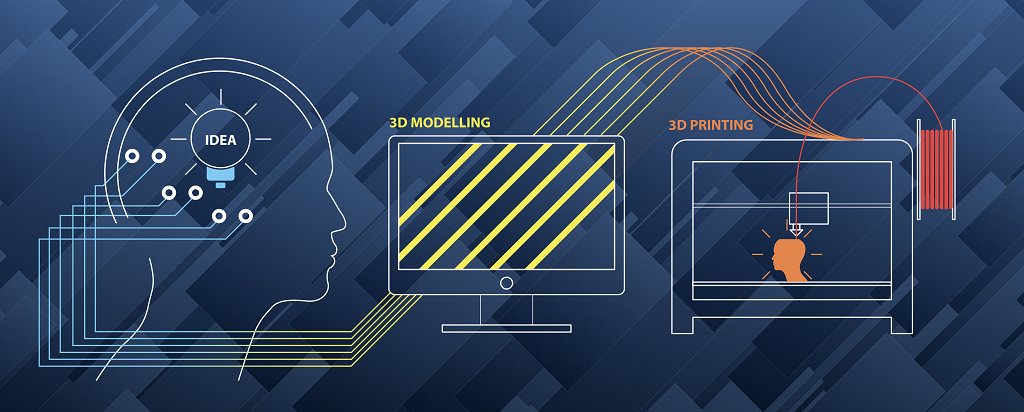
3D printing has revolutionised the way we produce objects – from toys to buildings and everything in between. It is poised to become a major disruptive technology with its ability to construct tailor made 3D objects of varying sizes and geometries by deposition of several sequential layers simply with the use of a digital file and printer. Its potential can transform the pharmaceutical industry, by significantly accelerating the speed of development of novel complex drug formulations and manufacturing processes and facilitating the creation of personalised medicines integrating patient-centricity seamlessly.
Manufacturing 3D printed drugs
A 3D printed medicinal product can be generated by simply replacing the ink with a desirable formulation of the drug and then streaming onto a suitable substrate in an additive process. Hence, to work with such ease, various advanced technologies are being adopted in 3D printing of pharmaceutical products. These include extrusion-based technique (involving hot melt extrusion and fused deposition modelling), powder-based and inkjet printing (involving continuous inkjet printing and drop on demand).
By eliminating intermediary stages of drug product manufacturing (such as blending, mixing, milling, and compression in case of solid oral dosage forms), 3D printing technology can facilitate accelerated production of high-quality products thereby optimising the manufacturing process and production cost substantially. Moreover, the capability of on-demand printing using 3D printing technology can enhance on-demand dispensing to improve medicine access and generate personalised medicines which is otherwise challenging to create in mass-produced batches.
Spritam® (levetiracetam), an anticonvulsant drug used in the treatment of epilepsy is the first and 3D printed prescription drug product approved by the US Food and Drug Administration (FDA). It was developed using ZipDose® technology by Aprecia® Pharmaceuticals. The ZipDose® technology prints a binder solution that consolidates powder containing API into rapidly dispersible tablets. As this approach reduces the complexity of ink formulation, it allows large-scale manufacturing of high dose orally disintegrating tablets.
Development of drugs using 3D printed technology
In the early phase of drug development, 3D printing enables an inexpensive and rapid means of production of small batches of high dose-flexible formulations for preclinical (or First in Human) trials. This is favoured because frequent dose escalations are common during the early development phase. Also, customised printlets can be developed based on the pharmacokinetic and pharmacodynamic characteristics of the animal model (i.e., small pellets, mini tablets) convenient for dosing in preclinical trials. 3D printing can also hasten the clinical trial process through speed and flexibility to produce small batches of drugs with different compositions.
Recently, a bioprinter has been developed by Hewlett-Packard (HP) to aid in the development of vaccines and drugs in the fight against COVID-19. As the demand for drugs and medical devices has considerably shot up, it has resulted in an increase in the use of 3D printing13 due to its robotic processing capability.
Challenges associated with 3D printing
Despite the myriad applications of 3D printing technology, it suffers from a few shortcomings. The wide use of 3D printing is restricted due to the cost and engineering challenges associated with it. Creating and printing the models also require individual monitoring and validation of the model especially when the item fabricated is a personalised one14. Further, the challenges associated with the performance of 3D-printed medicines, their in-vitro and in-vivo release, and control of the quality of 3D-printed formulation are significant15. Perhaps, the proliferation of counterfeit medicines is the industry’s greatest concern as printers can be hacked.
The US FDA guidance, ‘Technical Considerations for Additive Manufactured Medical Devices, December 2017’ highlights that due to variability in materials, printing characteristics, and parameters of additive manufacturing methods, it may not be possible to provide one universal set of guidelines for all 3D printing methods. These regulatory gaps and challenges need to be bridged to advance the modern manufacturing of medicines and successfully launch many more 3D printed products in the market.
Conclusion
To summarise, 3D printing technology serves as a potential tool to the pharmaceutical sector due to its flexibility and capability to create innovative drug products. It has revolutionised manufacturing to a great extent19. Tailoring of the drug products (as and when is needed) could largely cater to the need of personalised medicines. Although an increasing amount of drug development studies provide abundant benefits of this technology, it is still at an initial stage and great efforts are required to suitably evolve it to make it a success.
References
- Chen, G., Xu, Y., Kwok, P., & Kang, L. (2020). Pharmaceutical Applications of 3D Printing. Additive manufacturing, 34, 101209.
- Trenfield SJ, Madla CM, Basit AW, Gaisford S. The shape of things to come: emerging applications of 3D printing in healthcare. In: 3D Printing of Pharmaceuticals. Springer; 2018:1-19.
- Jamróz W, Szafraniec J, Kurek M, Jachowicz R. 3D printing in pharmaceutical and medical applications–recent achievements and challenges. Pharmaceutical research. 2018;35(9):1-22.
- Hsiao W-K, Lorber B, Reitsamer H, Khinast J. 3D printing of oral drugs: a new reality or hype? Expert opinion on drug delivery. 2018;15(1):1-4.
- Choong YYC, Tan HW, Patel DC, et al. The global rise of 3D printing during the COVID-19 pandemic. Nature Reviews Materials. 2020;5(9):637-639.
